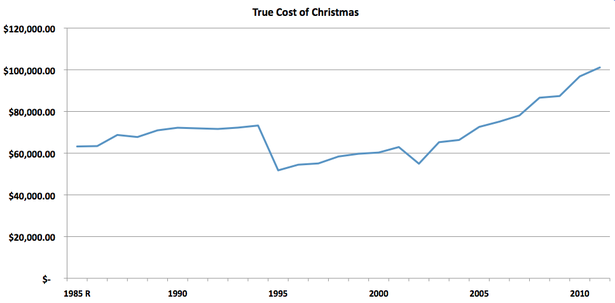 Every year, the wonderfully dorky economists with PNC bank celebrate "The 12 Days of Christmas" the way only wonderfully dorky economists could. They calculate what it would actually cost for your true love to buy 12 drummers drumming, 11 pipers pipers piping, and so on, all the way down to the partridge in the pear-bearing tree.
Every year, the wonderfully dorky economists with PNC bank celebrate "The 12 Days of Christmas" the way only wonderfully dorky economists could. They calculate what it would actually cost for your true love to buy 12 drummers drumming, 11 pipers pipers piping, and so on, all the way down to the partridge in the pear-bearing tree.
Unfortunately for very literal Christmas carolers, 2011 was the most expensive year yet for following the song's shopping instructions.
This year, the so-called Christmas Price Index hit a record $24,263 ... and that's not even the "true cost of Christmas." As you'll recall, the rather endless song requires your true love to make 12 separate excursions that leave you with 364 total gifts including not one partridge but 12, not two turtledoves but 22, and so on. The true cost of Christmas comes out to a rather staggering $101,119 and 84 cents, to be precise.
How do we get to $101K? It begins with the six geese (-a-laying) and the eight maids (-a-milking), which both come to about $6,300 per set. After the 12 days are over, total goose and maid purchases put you north of $50,000. Total dancing lady ($4700 per day) and calling bird ($645) expenses add another $20,000.
But what are the historical cost trends behind the Christmas Price Index? We knew you were wondering! So we compiled this chart based on data provided by PNC.
Nah. It turns out that PNC adjusted the price of swans from $1,000 per bird to $500 that year, leading to $21,000 in total swan discounts. In 2002, the price of swans was corrected again, leading to another dip. Then costs started rising really, really quickly. Behind the Christmas inflation were three big factors.
First, Americans haven't received any swan relief recently, and the price of the birds has doubled again. Second, PNC uses a local Philadelphia dance company to estimate the price of "nine ladies dancing," and that index has grown by nearly 50 percent this decade (and more than 300 percent overall in the last 30 years!). In fact, this highlights perhaps the biggest real-world lesson of the survey, which is that over the last 28 years, the price of services has increased much faster than the price of goods. Third, the price of golden rings has doubled since 2008 -- which won't surprise you if you've followed the gold rush that's occurred since the credit meltdown that year.
_____
Also in our mostly serious "Santanomics" series:
Is Christmas Bad for the Economy?
><
We want to hear what you think about this article. Submit a letter to the editor or write to letters@theatlantic.com.

